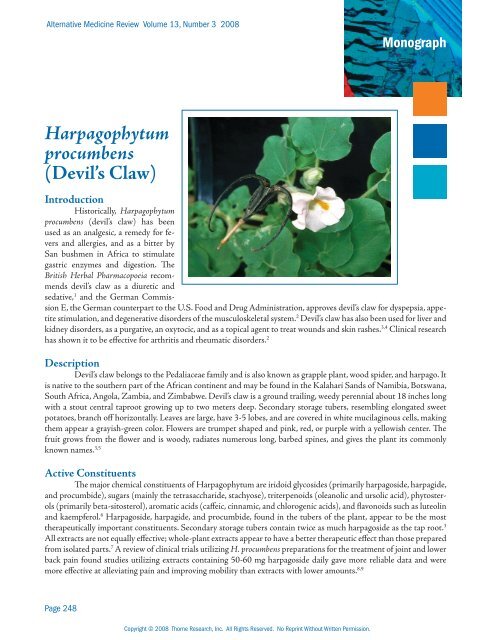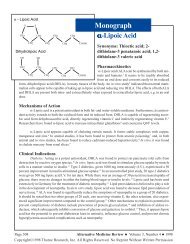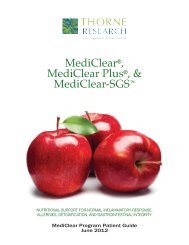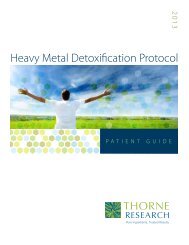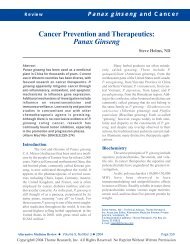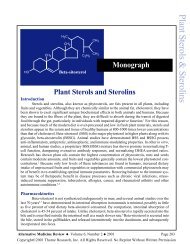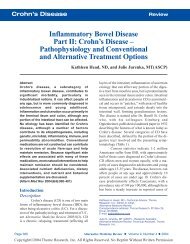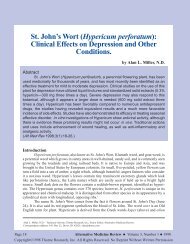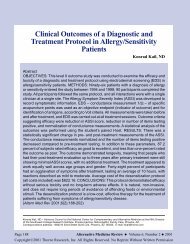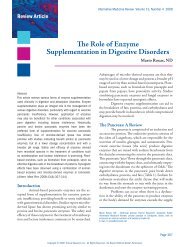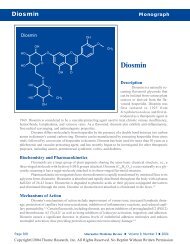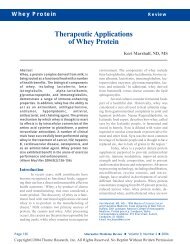Harpagophytum procumbens (Devil's Claw) - Thorne Research
Harpagophytum procumbens (Devil's Claw) - Thorne Research
Harpagophytum procumbens (Devil's Claw) - Thorne Research
- No tags were found...
Create successful ePaper yourself
Turn your PDF publications into a flip-book with our unique Google optimized e-Paper software.
Alternative Medicine Review Volume 13, Number 3 2008<strong>Harpagophytum</strong> <strong>procumbens</strong>OsteoarthritisIn a multicenter, uncontrolled trial, a tabletedmedication, Doloteffin® (2,400 mg aqueous extract ofdevil’s claw tubers equivalent to 50 mg harpagosidedaily) was given to 75 patients with osteoarthritisinducedknee and hip pain daily for 12 weeks. Painwas assessed via the Western Ontario and McMasterUniversities (WOMAC) questionnaire, a visual analogscale (VAS), and physician exam at baseline, six, and12 weeks. At 12 weeks the WOMAC total pain scorewas reduced by 22.9 percent and the VAS pain scoredecreased by 24.5 percent compared to baseline. Physicianassessment of pain reported a 46-percent improvementin pain on palpation, 35-percent improvement inmovement limitation, and 25.4-percent improvement injoint crepitus at 12 weeks. 13A larger study of Doloteffin involved 250 patientswith osteoarthritis of the knee (n=85) or hip(n=61), or nonspecific low-back pain (n=104) overeight weeks. Doloteffin dosage was 60 mg harpagosidedaily. After eight weeks, patients in the hip-pain andknee-pain groups demonstrated 35- and 37-percentimprovement in WOMAC scores compared to baseline,respectively. When averaging all pain indices measured,patients with hip pain experienced a 54-percentimprovement, while those with knee pain demonstrated38-percent improvement compared to baseline. Similarresults were observed for patients in the back-paingroup. 21 Despite limitations to this study, including lackof a control group and the variety of pain assessmentswith poor correlation among them, this surveillancestudy indicates a significant benefit of Doloteffin for osteoarthriticpain.The efficacy and safety of Harpadol®, a devil’sclaw powdered extract administered at 2,610 mg daily(435 mg per capsule; containing a total daily dosage of57 mg harpagoside) was studied for four months in 122patients suffering from knee and hip osteoarthritis andcompared to 100 mg daily diacerhein, an anthraquinonederivative (plant source not identified) with proven osteoarthritisameliorating properties. Severity of arthritiswas assessed via the Luquesne Index, a reliable toolused to rate pain. Harpadol administration resulted ina significant and progressive reduction in the index values,equal to that of diacerhein. Patients taking devil’sclaw also used significantly fewer non-steroidal antiinflammatorydrugs (NSAIDS) or other pain-relievingmedications than patients taking diacerhein, and thefrequency of adverse events was significantly lower inthe Harpadol group than in the diacerhein group. Harpadolwas shown to be at least as effective as diacerheinand resulted in fewer side effects. 14In an RCT, 89 subjects with osteoarthritis weregiven 2,000 mg (60 mg harpagoside) devil’s claw extract(n=45) or placebo (n=44) daily for eight weeks. Subjectsin the devil’s claw group experienced significant decreasein pain measured on the VAS scale compared toplacebo; significant improvement in mobility was alsoreported. 22Rheumatism/Low-Back PainA review of published literature conducted in2007 found 10 randomized, controlled trials utilizingH. <strong>procumbens</strong> for relief of low-back pain. 23 Althoughmany were methodologically flawed, three RCTs byChrubasik et al were of moderate-to-high scientificquality and demonstrated benefit. In the earliest trial,118 patients (59 in each group; 51 in treatment groupand 54 in placebo group completed study) ages 18-75with a six-month history of nonspecific low-back painwere given 6 g <strong>Harpagophytum</strong> (containing 50 mg harpagoside)or placebo for four weeks. After four weeks9/51 in the treatment group and 1/54 in the placebogroup were pain free. 24Effectiveness of <strong>Harpagophytum</strong> extract WS1531 (50 mg or 100 mg harpagoside daily) was evaluatedin 197 subjects with low-back pain. Patients wererandomly assigned to 50 mg harpagoside (n=65), 100mg harpagoside (n=66), or placebo (n=66) for fourweeks. The principal outcome measure was the numberof pain-free subjects assessed by the Arhus low-backpain index. After four weeks, 10, six, and three subjectswere pain free in the 100-mg, 50-mg, and placebogroups, respectively. Based on the Arhus index, however,the greatest symptomatic benefit was observed in the50-mg harpagoside group, with no additional benefit interms of decreased pain intensity with the higher doseof harpagoside. 25An RCT compared Doloteffin and Vioxx®for the treatment of low-back pain in 88 patients (44in each group) for six weeks. Patients received either2,400 mg Doloteffin (60 mg harpagoside) or 12 mgPage 250Copyright © 2008 <strong>Thorne</strong> <strong>Research</strong>, Inc. All Rights Reserved. No Reprint Without Written Permission.
MonographAlternative Medicine Review Volume 13, Number 3 2008Vioxx daily. Ten patients in the devil’s claw group reportedno pain without rescue medication during thesixth week of the trial, compared to five patients in theVioxx group. Eighteen Doloteffin patients and 12 Vioxxpatients reported greater than 50-percent reduction inaverage pain scores over the course of the trial. In termsof overall Arhus index pain scores, patients in the Doloteffingroup reported an average score decrease of 23percent compared to 26 percent in the Vioxx group. Adverseevents were also comparable in both groups. 26 Aone-year follow-up of this trial revealed a slight increasein improvement on the Arhus scores achieved in the pilotstudy. 27Botanical-Drug InteractionsDevil’s claw extract has been shown to inhibitcertain cytochrome P450 enzymes; therefore, mayhave an impact on numerous pharmaceutical drugsalso metabolized via these enzymes, including Coumadin,antihypertensives, statin drugs, anti-epileptic andanti diabetic agents, antidepressants, and proton pumpinhibitors. Devil’s claw extract moderately inhibitedCYP2C8/9/19 and CYP3A4 with IC 50values between100-350 μg/mL. The root extract also minimally inhibitedCYP1A2 and CYP2D6 with IC 50values >900 μg/mL. 28Because devil’s claw has been shown to lowerblood sugar in animals, caution is advised when givingdevil’s claw extracts to diabetic patients taking otherblood-sugar-lowering medications, 29 as it could potentiatetheir effects. H. <strong>procumbens</strong> also has been shown tocause a significant dose-dependent reduction of arterialblood pressure and heart rate in animals. A protectiveeffect against arrhythmias was also observed. 30 Therefore,devil’s claw extracts administered in conjunctionwith other medications that affect heart rhythm, bloodpressure, or heart rate may have an additive effect anddosages may need to be adjusted. Devil’s claw extractsalso appear to have some degree of blood thinning activity,30 so caution should be used when prescribing it withblood-thinning agents.Side Effects and ToxicityExtracts of H. <strong>procumbens</strong> appear to be safewhen used in appropriate dosages. Side effects arefew and usually limited to gastrointestinal upset.Harpagoside has been found to be of low toxicity withan LD 50>13.5 g/kg in mice. 31 In a review of 28 clinicaltrials of devil’s claw extracts, adverse events occurred ata rate of about three percent and did not exceed the rateof those experienced with placebo. Long-term use appearsto be safe and without toxicity. 32Warnings/ContraindicationsPatients with duodenal ulcers should probablyavoid using devil’s claw due to its effect on gastric pH. 18Because of reported oxytocic properties, devil’s claw extractsare contraindicated during pregnancy. 18DosageDevil’s claw extracts can be administered in severalforms; dosage varies with each, depending on concentrationof active constituents present. The followingare typical dosages used historically and clinically. 33Dried Root: 0.5-1.0 g dissolved in water givenorally three times daily for appetite stimulation andstomach upset.Dried root powder (tablet or capsule):1,800-2,400 mg (50-100 mg harpagoside) daily for arthritisand musculoskeletal pain and inflammation.Crude aqueous root extract: 2-9 g daily forlow-back pain and osteoarthritis.References1. British Herbal Medicine Association. British HerbalPharmacopoeia. 2nd ed. Bournemouth, UK: BritishHerbal Medicine Association; 1983.2. Blumenthal M. The Complete German CommissionE Monographs. Austin, TX: American BotanicalCouncil; 1998:120-121.3. Devil’s claw tuber. http://www.altcancer.com/phyto/devils_claw.htm [Accessed July 11, 2008]4. Ragusa S, Circosta C, Galati EM, Tumino G. Adrug used in traditional medicine. <strong>Harpagophytum</strong><strong>procumbens</strong> DC. I. Scanning electron microscopeobservations. J Ethnopharmcol 1984;11:245-257.5. <strong>Harpagophytum</strong> <strong>procumbens</strong> monograph. http://www.wwf.org.uk/filelibrary/pdf/h<strong>procumbens</strong>.pdf[Accessed July 11, 2008]6. Bradley PR, ed. British Herbal Compendium Vol. 1.Dorset, UK: British Herbal Medicine Association;1992.7. <strong>Harpagophytum</strong> <strong>procumbens</strong> (Burch.) DC. http://www.plantzafrica.com/planthij/plimageshij/harpagpro.jpg [Accessed on July 17, 2008]Page 251Copyright © 2008 <strong>Thorne</strong> <strong>Research</strong>, Inc. All Rights Reserved. No Reprint Without Written Permission.


